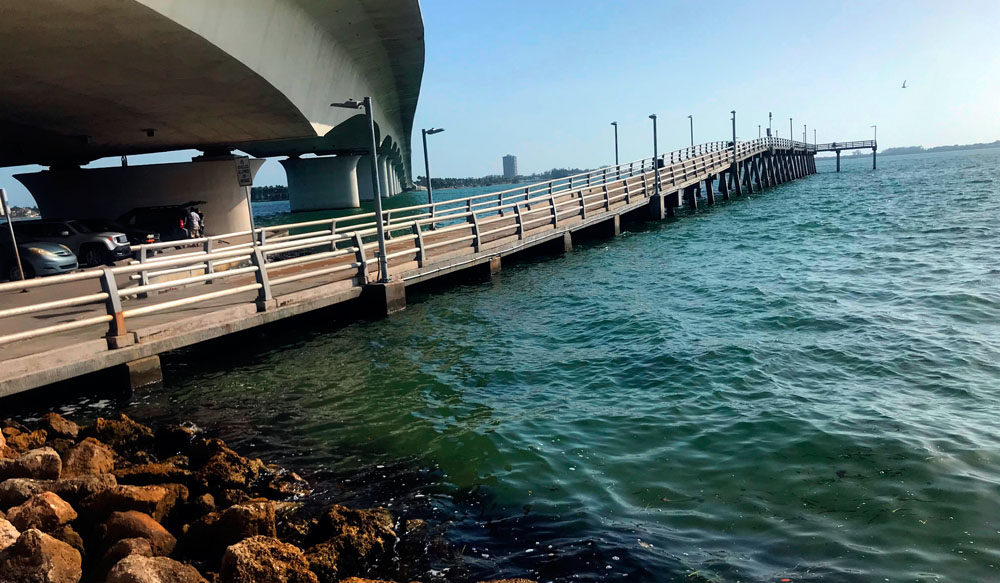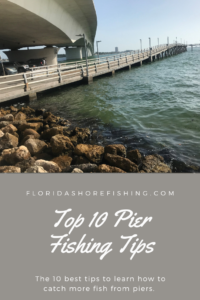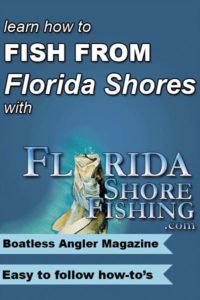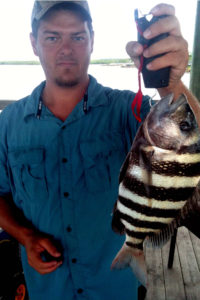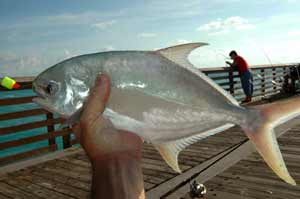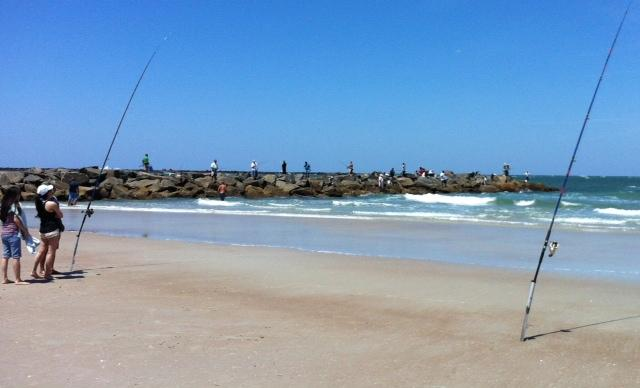Some of the best fishing to be found along Florida's coasts is found fishing from a pier. Florida offers a wide range of public and private piers all along its shores. Here are the top 10 pier fishing tips to help you enjoy your trip more and make that trip more productive!
Top 10 Pier Fishing tips
- Don't always fish the deep end
- Use a variety of bait to find what works best
- Look for pot holes under the pier
- Learn to read the water
- Bring A Hoop Net (or fish at a pier that provides one)
- Allow fish to untangle themselves
- Find the through behind breaking waves
- Use appropriate gear
- On crowded days use enough weight to hold bottom to avoid tangles
- Have Fun
1. Don't always fish the deep end
The deepest end of the most piers almost always fills up with anglers first. These anglers believe that the deeper the water the more fish there will be and the bigger the fish will be. Experienced anglers have found that this is not always the case, and in fact, it is most frequently wrong. Many larger fish as well as large schools of fish congregate in the shallow water. The bait fish use the shallows to hide in, the larger fish are in search of a meal!
2. Use a variety of bait to find what works best
Most anglers that have fished more than a few times have a go-to bait. One that they have supreme confidence in and will use almost every time they go fishing. But, sometimes the fish do not want to eat that bait. A great tactic to use from a pier is to use a dropper rig with 2 hooks. One hook will have one type of bait, the other hook a different type. If the fish favor one bait of the other that day, this technique will help identify the bait they favor.
3. Look for pot holes under the pier
Most piers will have surf and/or tidal action underneath them. This water movement will often times cause pot holes to form in the sand/mud under the pier. These pot holes attract bait fish and predators alike. When looking down in clear water they are relatively easy to spot. In murky water look for areas of darker water, normally behind a pylon. Put the bait just up current of the hole and allow the current to take it into the pothole and hold on tight!
4. Learn to read the water
Watching the water under and around a pier will tell you a lot about what is happening bellow the surface. For example, if there is a boil of water in an area that is unexpected there is most likely some sort of sub-surface structure. Areas like that will quite frequently hold fish. When fishing is slow, take some time and just look at the water. Learn how it SHOULD move and take note of areas where it moves differently. The areas where the water moves differently than it should will almost always hold fish.
5. Bring a Hoop Net (or fish on pies that provide them)
Most piers found around the Florida coast are pretty high above the water. This height has its advantages (keeps the anglers dry and provides good visibility) but it also has one major disadvantage. Pulling a fish from the water to the pier with out a net can be difficult when the fish is either large or quite active on the way up. Many fish are lost trying to just pull the fish up because of broken lines or the fish simply pulling the hook. A hoop net solves this problem. Bring one with you if you are fishing a pier that does not have one. Also, be willing to help others land their fish using a hoop net and they will be more than happy to help you when its your turn!
6. Allow fish to untangle themselves
Many fish that are lost on piers are lost when a fish wraps its self around a pylon. The line will sometimes break from the friction, but many times it is broken by the angler who either looses patients or attempts to pull the fish away from the pylon. A trick that works many times is to simply allow the fish to untangle its self. When a fish wraps around a pylon simply feed line out to allow some slack. Put the pole in a secure area and let it sit for a few minutes. Often the fish will figure out how to reverse course and untangle its self.
7. Find the through behind breaking waves
Most beaches will have 2 areas where waves break. The first area is a sand bar, the second is close to the beach. More often than not there will be a through (a deeper area that runs parallel to the beach) behind the breaking waves. This area is a five star restaurant to larger fish, the surf kicks up forage and the depth provides cover! Locate these areas and fish are almost certain to be there.
8. Use appropriate gear
One of the most common mistakes witnessed on piers is anglers fishing with inappropriate gear. Using gear that is either to small or to large will lead to a lack in fishing productivity. For most piers a spinning real that can handle 20lb test line with rods of no longer than 7' will work great. The majority of fish that are caught from piers can be handled by this type of gear. When targeting larger fish, such as sharks or kingfish use much larger equipment.
9. Avoid tangles on crowded days
The single biggest complaint about fishing from piers is that they can get crowded and lines get tangled up. Some techniques to avoid getting tangled are to use enough weight to stop your bait from moving into others lines, fish strait down instead of casting far out (more fish are caught strait down anyway), avoid fishing by those that are obviously inexperienced and find a spot with fewer people. Tangles are a part of fishing from any structure or party boat that has multiple people on it, but using steps to avoid it and a calm demeanor when it does happen will make for a better fishing day for all involved.
10. Have fun
Fishing from a pier in Florida can be one of the most rewarding types of fishing. It is relaxing, can often be quite productive and there are many unique traits to pier fishing. Many piers have restaurants, gift shops, bars and other amenities on the pier. These amenities can make the slow fishing hours even more enjoyable than they normaly would be. On top of all that, most piers have a great view! So get out there and have fun fishing from one of Florida's Piers!


